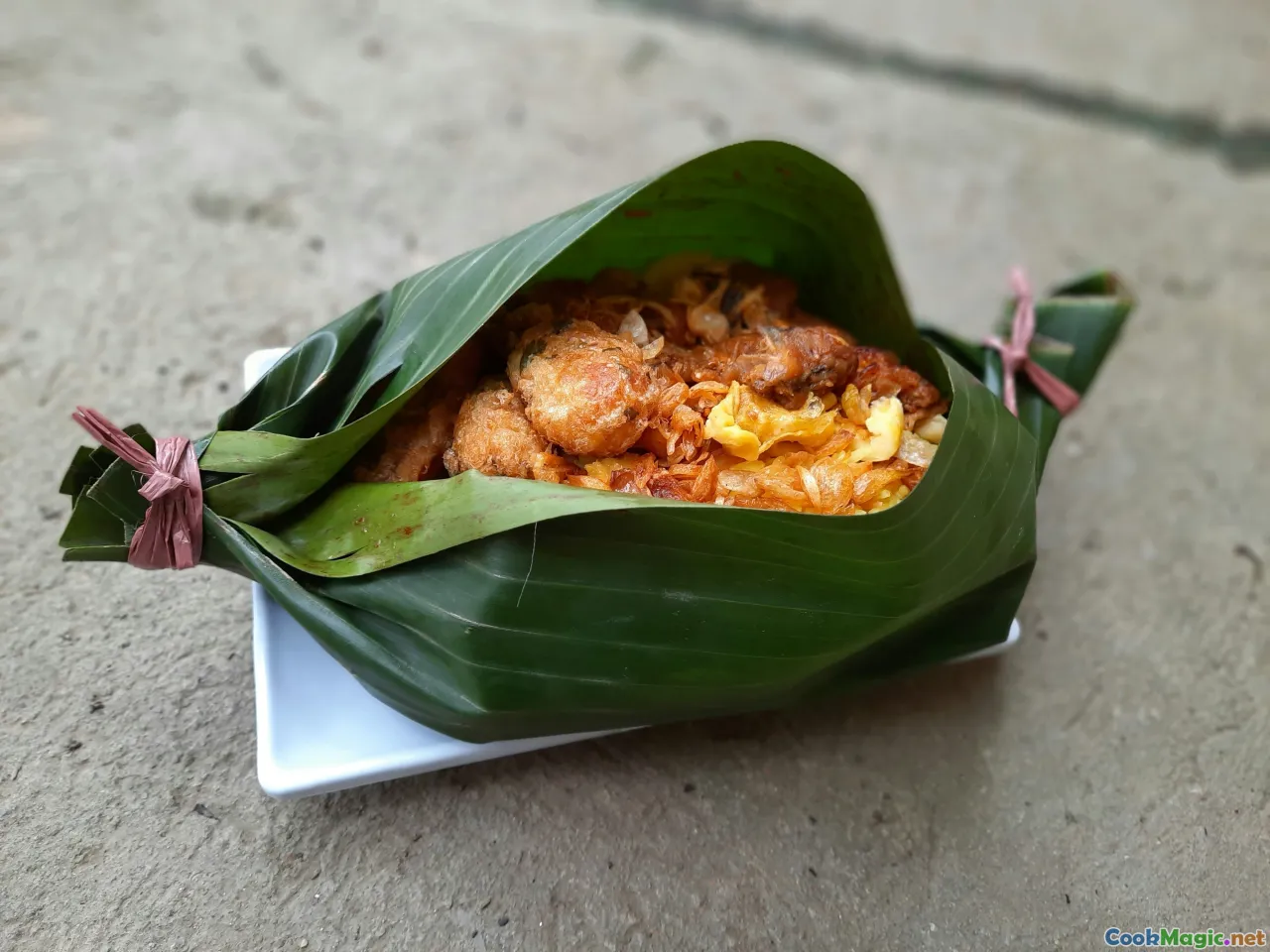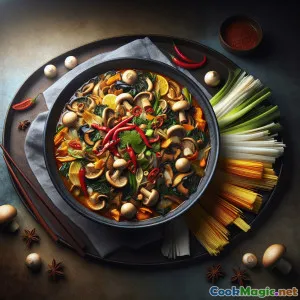
Хрустящий пряный темпе полуострова
(Peninsular Spiced Tempeh Crunch)
(0 Обзоры)0
178
октябрь 06, 2025
Сообщить о проблеме
Ингредиенты
-
400 grams Темпе
(Firm soybean tempeh, cut into bite-size batons)
-
1.5 tbsp Соевый соус
(Use tamari for gluten-free)
-
1 tbsp Паста из тамаринда
(Adds tang; substitute 1 tbsp lime juice if unavailable)
-
1 tsp Пальмовый сахар
(Brown sugar works in a pinch)
-
3 cloves Чеснок
(Crushed to a paste)
-
15 grams Свежий имбирь
(Тонко натертый)
-
1 stalk Лемонграсс
(Tender inner core, minced)
-
0.5 tsp Молотая куркума
(Для цвета и тепла)
-
1 tsp Молотый кориандр
(Fragrant base spice)
-
0.5 tsp Молотый тмин
(Nutty depth)
-
0.25 tsp Белый перец
(Sub black pepper if needed)
-
60 grams Рисовая мука
(Ultra-crisp coating)
-
40 grams Кукурузный крахмал
(Or tapioca starch)
-
0.5 tsp Разрыхлитель теста
(Boosts cragginess and lightness)
-
0.75 tsp Мелкая соль
(Регулируйте по вкусу)
-
300 ml Нейтральное масло
(For shallow-frying; use peanut, canola, or sunflower)
-
2 tbsp Вода
(For creating a clinging slurry on the coating)
-
30 grams Жареный арахис
(Lightly crushed into shards)
-
20 grams Несладкие кокосовые хлопья
(Toast lightly for aroma)
-
4 leaves Листья кафир-лайма
(Very finely sliced (chiffonade))
-
10 leaves Листья карри
(Flash-fry until translucent and crisp)
-
2 whole Перчики «Bird’s eye»
(Slit lengthwise for gentle heat)
-
2 stalks Зеленый лук
(Thinly sliced on the bias)
-
1 whole Лайм
(Нарежьте на дольки для подачи)
-
60 ml Кокосовое молоко
(Optional drizzle)
-
1 tbsp сок лайма (дополнительно)
(For the drizzle)
-
1 tsp Лёгкий соевый соус или тамари (для поливки)
(Balances the coconut-lime drizzle)
(Firm soybean tempeh, cut into bite-size batons)
(Use tamari for gluten-free)
(Adds tang; substitute 1 tbsp lime juice if unavailable)
(Brown sugar works in a pinch)
(Crushed to a paste)
(Тонко натертый)
(Tender inner core, minced)
(Для цвета и тепла)
(Fragrant base spice)
(Nutty depth)
(Sub black pepper if needed)
(Ultra-crisp coating)
(Or tapioca starch)
(Boosts cragginess and lightness)
(Регулируйте по вкусу)
(For shallow-frying; use peanut, canola, or sunflower)
(For creating a clinging slurry on the coating)
(Lightly crushed into shards)
(Toast lightly for aroma)
(Very finely sliced (chiffonade))
(Flash-fry until translucent and crisp)
(Slit lengthwise for gentle heat)
(Thinly sliced on the bias)
(Нарежьте на дольки для подачи)
(Optional drizzle)
(For the drizzle)
(Balances the coconut-lime drizzle)
Питательная ценность
- Порции: 4
- Размер порции: 1 чаша (200 г)
- Calories: 430 kcal
- Carbohydrates: 0 g
- Protein: 24 g
- Fat: 24 g
- Fiber: 7 g
- Sugar: 6 g
- Sodium: 720 mg
- Cholesterol: 0 mg
- Calcium: 120 mg
- Iron: 3.8 mg
Инструкции
-
1 - Prep the tempeh:
Pat the tempeh dry and cut into 2–3 cm batons. Drying helps the marinade cling and ensures a crisp fry.
-
2 - Build the peninsular spice paste:
In a mortar or processor, pound/whiz garlic, ginger, lemongrass, tamarind, soy sauce, palm sugar, turmeric, coriander, cumin, and white pepper into a paste.
-
3 - Marinate briefly:
Toss tempeh with the spice paste until evenly coated. Rest 10–15 minutes to absorb flavors without softening the texture.
-
4 - Mix the crisp coating:
Combine rice flour, cornstarch, baking powder, and salt in a bowl. Keep it dry and airy.
-
5 - Dredge and crag the surface:
Toss marinated tempeh in the flour mix to coat. Sprinkle in 1–2 tbsp water and toss vigorously to form little clinging clumps for extra crunch.
-
6 - Heat the Oil:
Pour neutral oil into a deep skillet (about 1 cm depth). Heat to 175–180°C; a pinch of coating should fizz and brown in 30–40 seconds.
-
7 - Fry the tempeh:
Fry in batches without crowding, turning until deep golden and crisp, 3–4 minutes per side. Drain on a rack or paper towels; season lightly with salt.
-
8 - Crisp the aromatics:
In the hot oil, flash-fry curry leaves, lime leaves, chilies, and coconut flakes 10–20 seconds until fragrant. Drain immediately to avoid browning.
-
9 - Optional coconut-lime drizzle:
Whisk coconut milk, additional lime juice, and 1 tsp soy/tamari with a pinch of salt. Serve on the side to preserve crunch.
-
10 - Finish and Serve:
Toss crisp tempeh with roasted peanut shards and fried aromatics. Scatter scallions, add lime wedges, and serve immediately.
Pat the tempeh dry and cut into 2–3 cm batons. Drying helps the marinade cling and ensures a crisp fry.
In a mortar or processor, pound/whiz garlic, ginger, lemongrass, tamarind, soy sauce, palm sugar, turmeric, coriander, cumin, and white pepper into a paste.
Toss tempeh with the spice paste until evenly coated. Rest 10–15 minutes to absorb flavors without softening the texture.
Combine rice flour, cornstarch, baking powder, and salt in a bowl. Keep it dry and airy.
Toss marinated tempeh in the flour mix to coat. Sprinkle in 1–2 tbsp water and toss vigorously to form little clinging clumps for extra crunch.
Pour neutral oil into a deep skillet (about 1 cm depth). Heat to 175–180°C; a pinch of coating should fizz and brown in 30–40 seconds.
Fry in batches without crowding, turning until deep golden and crisp, 3–4 minutes per side. Drain on a rack or paper towels; season lightly with salt.
In the hot oil, flash-fry curry leaves, lime leaves, chilies, and coconut flakes 10–20 seconds until fragrant. Drain immediately to avoid browning.
Whisk coconut milk, additional lime juice, and 1 tsp soy/tamari with a pinch of salt. Serve on the side to preserve crunch.
Toss crisp tempeh with roasted peanut shards and fried aromatics. Scatter scallions, add lime wedges, and serve immediately.
Подробнее о: Хрустящий пряный темпе полуострова
Why this recipe works
Peninsular Spiced Tempeh Crunch is a love letter to the flavors that sweep across the Malay Peninsula and the Indonesian archipelago—citrusy lemongrass, earthy turmeric, warm coriander and cumin, and a lively lift of tamarind. Tempeh, a proud Indonesian invention, brings a nutty depth and satisfying protein that crisps beautifully when treated correctly. The technique leans on a few pro tricks: a short, punchy marinade to perfume the tempeh without sogging it out; a rice flour–cornstarch blend for a glassy, shattering finish; and a last-minute “cragging” step where a splash of water helps the coating form crunchy, crinkled bits. The result is architectural: crisp outside, meaty within, and threaded with pockets of spice.
The garnish isn’t just garnish. Flash-fried curry leaves and slivered kaffir lime leaves perfume the air with a Southeast Asian signature—aromatic, citrusy, and herbaceous—while coconut flakes and crushed roasted peanuts add layers of texture that echo the tempeh’s nutty character. Serving a coconut-lime drizzle on the side keeps the crunch intact while giving diners the option to add a cooling, creamy-acidic counterpoint.
Tips & notes
- Keep it dry: Pat the tempeh thoroughly. Surface moisture fights your crust.
- Temperature matters: Aim for 175–180°C oil. Too low and you’ll get greasy; too high and the spices scorch.
- Craggy magic: After dredging, sprinkle in water and toss—those tiny clumps fry into extra ridges of crunch.
- Gluten-free swap: Use tamari and confirm your baking powder is GF.
- Heat control: Bird’s eye chilies bring sharp heat; deseed or omit for a milder bite.
- Oil economy: Shallow-fry in a broad skillet rather than deep-frying. Drain on a rack to retain crispness.
- Make-ahead: Marinate up to 4 hours in the fridge. Dredge and fry just before serving.
- Re-crisp: Air-fry 3–4 minutes at 190°C or oven-bake at 200°C for 6–8 minutes to revive leftovers.
History & cultural significance
Tempeh is a cornerstone of Indonesian cuisine, originating in Java centuries ago. Unlike tofu, it is a whole-bean fermentation that binds soybeans with a delicate mycelium, concentrating protein and fiber while deepening flavor. Its ubiquity in Indonesia meets the spice-route heritage of the peninsula: lemongrass from tropical gardens; turmeric, coriander, and cumin reflecting ancient trade; and the unmistakable, sunny perfume of kaffir lime leaf. This dish fuses those threads into a modern, street-snack sensibility—equally at home as a shared appetizer, a rice bowl topper, or a bar bite beside an ice-cold drink.
Substitutions & variations
- Citrus swaps: If kaffir lime leaves are scarce, use finely grated lime zest and a little extra lemongrass.
- Nut-free version: Omit peanuts; add toasted pumpkin seeds for crunch.
- No tamarind? Use lime juice with a pinch more sugar to mimic sweet-tart balance.
- Baked method: Oil-toss dredged tempeh, spread on a parchment-lined tray, and bake at 220°C, flipping once, until golden (15–20 minutes). Finish with fried aromatics.
- Sweet-heat glaze: Warm 1 tbsp palm sugar with 1 tbsp water and a dash of chili paste; toss very lightly with the fried tempeh just before serving.
Serving ideas
- Over coconut rice with quick-pickled cucumbers and carrots.
- Tucked into lettuce cups with herbs, drizzled with the coconut-lime sauce.
- As a topping for noodle salads or grain bowls; it stays audibly crisp.
Unique aspects
The method blends Indonesian tempeh know-how with peninsula aromatics and a hawker-style finish. The “cragging” technique, often seen in ultra-crisp fried chicken, is reimagined for tempeh, which can handle bold flavors and higher heat. The optional coconut-lime drizzle preserves texture autonomy: sauce on the side rather than over the top, so each bite can be customized.
Chef’s thoughts
This is snack food engineered for sound as much as flavor—the first bite should crackle. The profile rides a perfect line between nostalgic and new: familiar spice warmth, tropical perfume, and a clean, bright finish. It’s plant-based cooking at its most celebratory: abundant in texture, generous in aroma, and designed to share. If you’re new to tempeh, this dish is the on-ramp; if you already love it, the peninsular spice treatment might become your house standard.






















